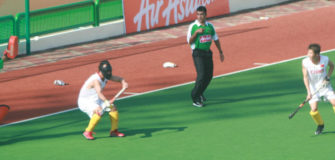Horst Wein: Taking Hockey Into the Future
Share
Taking Hockey Into the Future
” The hockey of the past we have to respect, the hockey of today we must study, and the hockey of the future we should anticipate.” Horst Wein
Neil Postman, a professor of sociology at the University of New York, states in his well-known book The Extinction of Childhood (1992) that modern society often does not allow children to distinguish their mode of living from that of adults. “They are eating the same food, they are watching the same television program, commit crimes like adults, take alcohol at an early age as well as drugs, etc.” He further states, “The world of labor is also getting out of control. Girls between 12 and 17 years of age are, today, among the world’s best-paid models, and there are children that, at the age of 8, are already multimillionaires (e.g., actors or pop stars). It is impossible that these children are behaving and will behave in the future as normal children would. . . .”
According to Postman, it’s very dangerous when society does not notice much difference between the world of children and that of adults. He believes that children must discover the mysteries of life slowly and step by step, always in accordance with their mental stage and their present capacities.
The environment that children move and play in today has suffered an enormous transformation from nature to “urban jungle.” This development has denied children the chance to learn from and follow nature. Instead they are more often forced to move “against their own nature” (e.g., to cross the road only when there is a zebra path or play computer games instead of outdoor games in fresh air). Since children have lost the natural setting, which influenced the education and development of their parents and grandparents, they should be given modern surroundings for learning and gaining experience on their own that can replace the former ones. This is why having organized sports in schools and clubs is so important for the quality of life of our youth!
Our world of hockey reflects the current situation. Instead of children being able to practice their particular games, as in the past, in the streets or other natural settings, the increasing urbanization of the landscape does not allow the most of them to make use of the natural surroundings that their grandparents had for play.
Besides having to play the game on artificial grass fields far away from their homes, in our advanced society young boys and girls—in many clubs and schools—must maintain rigid training methods and competitions. These old-fashioned methods in no way respect the laws of nature or the children’s actual mental and physical capacities.
Everywhere children are obliged to train and compete like adults, forced to adapt to rules originally intended for adults. The rush to introduce talented youth to the adult game has frequently resulted in their acquiring bad habits that later limit their performance on our senior teams.
Children should take part in games that are specially designed for their age, rather than being rushed into the complex adult game.
We know that when an institution organizes a competition, it determines to a high degree the objectives, contents, and methods of the children’s training and learning process. That means that if the structure of the competition is wrong, the way the coach trains them must also be incorrect.
Experience shows that coaches of young players are seen positively by the parents and club officials only when the kids demonstrate success or winning. But to achieve this kind of success in the traditional competition, the coaches must train them in a very similar way to the adults, with more or less the same contents and methods.
Beginners in such a system are obliged to compete every weekend in a match where success is conditioned mainly by one specific skill (the long pass) and often by destructive or negative tactics. This forces the coaches, in the limited available practice time (generally 3 hours a week), to concentrate almost exclusively on match-winning aspects. They are afraid to “waste time” in developing the children at the initial stage through a wide range of physical activities and problem-solving situations. But it is only in this systematic way that a sound level of coordination and conditioning capacities can be acquired. And these, as we all well know, are indispensable for the further improvement of young players’ performance.
Although all sport scientists agree on this developmental model, few sports federations are making use of the important recommendations these professionals make. Instead of copying nature and patiently developing all the necessary capacities, through training and competitions tailored to the children’s capacities, many coaches of young players still force them to play like clones of an adult.
Modifying Postman’s words slightly we might affirm the statement, “Once we give the children access to the forbidden fruit of adult information [competition], we expel them from the garden of infancy.” It does seem as though, in many parts of the world and also in India, there are too many teachers and coaches of young soccer players still living in the Middle Ages. Why call it that? In the Middle Ages society knew only infants and adults. By seven or eight years of age, a person was already considered adult because he participated in adult activities: the child worked, ate, dressed, and behaved as an adult.
For how long can we allow the ignorance of our coaches and especially of the administrators to continue to obstruct the natural development of the next generation of hockey players in India?
“The best advice I could give to young players is to make use of every minute and don’t hide in a box that others he constructed for them.”
Michael Jordan
Courtesy: Artcle courtesy Horst Wein


